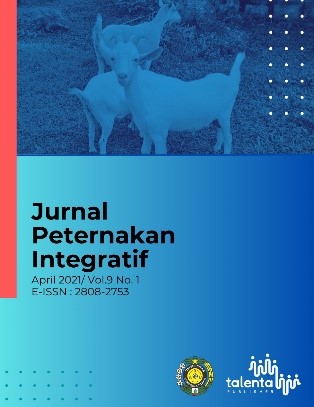Nutritional Content of Fermented Kepok Banana Peel (KBP) by Local Microorganisms (MOL)
DOI:
https://doi.org/10.32734/jpi.v9i1.6488Keywords:
fermentation, kepok banana peel, MOL, nutritional contentAbstract
KBP is a waste from processing of Kepok banana which has not been used optimally because it has low nutritional content. One way to improve nutritional quality of KBP by fermentated process. This study aims to examine the nutritional content of fermented KBP with various doses of MOL and fermentation time. The research was conducted by using an experimental method using a completely randomized design (CRD) with 3 x 3 factorial pattern and 3 replications. The first factor was various doses (D1 = 1%; D2 = 3%; D3 = 5%) and second factor was fermentation time (L1 = 3 days; L2 = 5 days; L3 = 7 days). The variables observed were moisture and dry matter content, crude protein, crude fat, crude fiber, ash, and BETN. The results showed that fermentation of KBP using various doses of MOL had a very significant effect (P <0.01) on moisture content, dry matter, crude protein, ash, but had no significant effect (P> 0.05) on crude fiber, crude fat and BETN. Fermentation time had no significant effect (P> 0.05) on moisture content, dry matter, crude protein, crude fiber, crude fat, and BETN, but had a very significant effect (P <0.01) on ash content. There was an interaction between MOL dose and fermentation time on BETN levels but there was no interaction between MOL dose and fermentation time on moisture content, dry matter, crude protein, crude fiber, crude fat and ash. The conclusion of this research is fermentation of KBP using MOL up to 5% increased dry matter content, crude protein, and decreased moisture content and ash content.
Downloads
Downloads
Published
Issue
Section
License
Copyright (c) 2021 Jurnal Peternakan Integratif

This work is licensed under a Creative Commons Attribution-ShareAlike 4.0 International License.
The Authors submitting a manuscript do so on the understanding that if accepted for publication, copyright of the article shall be assigned to Jurnal Peternakan Integratif as well as TALENTA Publisher Universitas Sumatera Utara as the publisher of the journal.
Copyright encompasses exclusive rights to reproduce and deliver the article in all forms and media. The reproduction of any part of this journal, its storage in databases and its transmission by any form or media, will be allowed only with written permission from Jurnal Peternakan Integratif.
The Copyright Transfer Form can be downloaded here.
The copyright form should be signed originally and sent to the Editorial Office in the form of original mail or scanned document.















